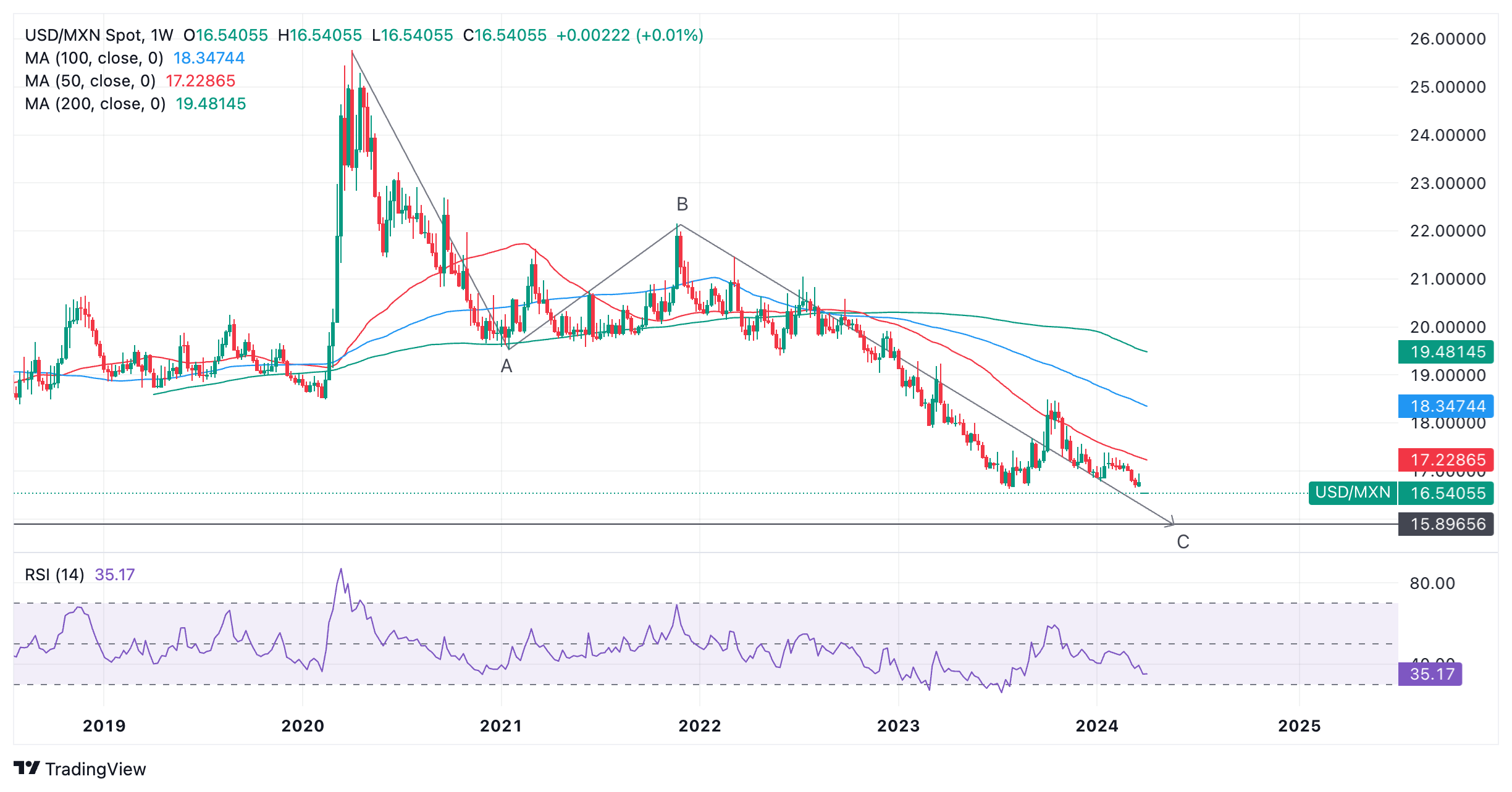- The Mexican Peso continues to strengthen against the US Dollar following worse than expected US services data.
- Inflation in the US service sector appears to be slowing, which could signal the possibility of an early interest rate cut by the Fed.
- The long-term trend of the USD/MXN pair is bearish, but signs and omens on the charts suggest a risk of recovery.
During the day on Thursday, the Mexican peso oscillated between tepid losses and gains against the US dollar.
The recent trend for the Peso has been upward, with the USD/MXN weakening after the release of lower-than-expected US ISM Services PMI figures, which recalibrated views on the persistence of the US inflation a key factor for USD pairs.
The publication of the Minutes of the March meeting of the Bank of Mexico (Banxico) at 15:00 GMT is the next key event for the Mexican Peso on Thursday. At that meeting, Banxico decided to cut interest rates by 0.25% for the first time since 2021. It is expected to be the beginning of a flexibility cycle, according to a note from BBH analysts. Therefore, the minutes of the meeting could be carefully examined for clues.
Mexican Peso extends bullish trend after US services data comes in lower than expected
The price of the Mexican peso against the US dollar rose after the publication on Wednesday of the US ISM services PMI data. The March figures showed an unexpected decline to 51.4 from the previous 52.6, when a slight increase to 52.7 was expected.
Perhaps more important was the sharp drop in the prices paid component of the services ISM, which measures inflation in the sector. In March it registered a decrease to 53.4 points, compared to 58.6 in February.
-638478213864341723.png)
Prices paid for ISM Services: monthly
The prices paid component is significant for the US dollar and USD/MXN because services inflation is considered particularly persistent by economists and the Federal Reserve (Fed) has said it is carefully watching price pressures in the sector. while deliberating whether or not to cut interest rates.
The decrease in interest rates or their expectation is negative for the US dollar, since they reduce its attractiveness for foreign capital, reducing inflows.
Given the sudden decline in services inflation revealed by the prices paid metric, it seems more likely that the Fed will decide to cut interest rates as early as June, as expected.
Recent strong US data and the threat of a resurgence of inflationary forces had pushed back bets on a rate cut in June or even suggested the Fed could wait until 2025.
However, March services data has once again raised the likelihood of a Fed rate cut in June, above the 60% level, according to CME's FedWatch tool, a market-based indicator of future moves. of monetary policy.
Technical analysis: USD/MXN in long downtrend
USD/MXN is at the end of a long-term downtrend that began after the pair reached a high of 25.76 in April 2020 – we are now at 16.50.
The long move lower could be characterized as a very large three-wave pattern called the Measured Move. Such patterns are composed of a wave A, B and C, with wave C extending to a similar length to wave A, or a Fibonacci ratio 0.618% of A.

US Dollar vs. Mexican Peso: Weekly Chart
If such a pattern is really developing, the price has almost reached the point where C will equal A, calculated at 15.89. It has also already surpassed the 0.625% Fibonacci level.
It has also surpassed the conservative target for the end of C at the 0.618% Fibonacci extension of A (at 18.24).
Once the pattern is completed, the market usually reverses its trend or undergoes a substantial correction.
The Relative Strength Index (RSI) is converging quite a bit with the price, which is a sign that the downtrend could be losing momentum. Although in 2024 the price has pressed below the level of the 2023 lows, the RSI has not followed suit. This lack of correlation may be a precursor to a recovery. However, since there has been no price reaction yet, it is simply further evidence that the downtrend may be easing, rather than anything concrete.
A real turnaround in price would be needed to support the view that a turnaround is coming, and this has not yet occurred.
Frequently Asked Questions about the Mexican Peso
What is MXN?
The Mexican Peso is the legal tender of Mexico. The MXN is the most traded currency in Latin America and the third most traded on the American continent. The Mexican Peso is the first currency in the world to use the $ sign, prior to the later use of the Dollar. The Mexican Peso or MXN is divided into 100 cents.
What is Banxico and how does it influence the MXN?
Banxico is the Bank of Mexico, the country's central bank. Created in 1925, it provides the national currency, the MXN, and its priority objective is to preserve its value over time. In addition, the Bank of Mexico manages the country's international reserves, acts as a lender of last resort to the banks and advises the government economically and financially. Banxico uses the tools and techniques of monetary policy to meet its objective.
How does inflation impact the MXN?
When inflation is high, the value of the Mexican Peso (MXN) tends to decrease. This implies an increase in the cost of living for Mexicans that affects their ability to invest and save. At a general level, inflation affects the Mexican economy because Mexico imports a significant amount of final consumption products, such as gas, fuel, food, clothing, etc., and a large amount of production inputs. On the other hand, the higher the inflation and debt, the less attractive the country is for investors.
How does the Dollar influence the Mexican Peso (MXN)?
The exchange rate between the USD and the MXN affects imports and exports between the United States and Mexico, and may affect demand and trade flows. The price of the Dollar against the Mexican Peso is affected by factors such as monetary policy, interest rates, the consumer price index, economic growth and some geopolitical decisions.
How does the Fed's monetary policy affect Mexico?
The exchange rate between the USD and the MXN affects imports and exports between the United States and Mexico, and may affect demand and trade flows. The price of the Dollar against the Mexican Peso is affected by factors such as monetary policy, interest rates, the consumer price index, economic growth and some geopolitical decisions.
Source: Fx Street
I am Joshua Winder, a senior-level journalist and editor at World Stock Market. I specialize in covering news related to the stock market and economic trends. With more than 8 years of experience in this field, I have become an expert in financial reporting.







